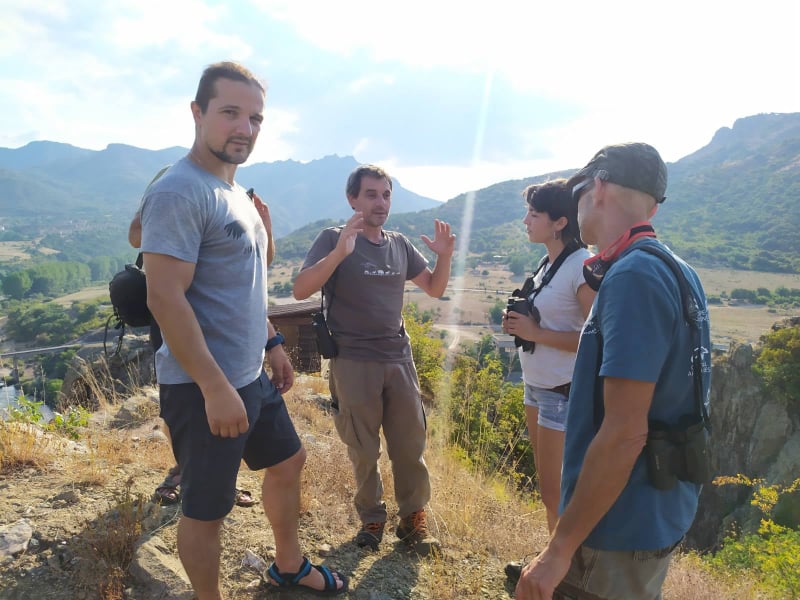A positive site survey means the reintroduction of cinereous vultures in the Rhodope Mountains rewilding area in Bulgaria can begin in 2021. Overseen by the Rewilding Rhodopes team and partners, the return of this keystone species to the area as a breeding species will enhance local food chains.
Preparations for the groundbreaking reintroduction of cinereous (black) vultures in the Rhodope Mountains of Bulgaria took a step forward at the end of July, with a visit to the area by a team of Spanish experts.
Representatives of Spanish NGO GREFA (Group for Native Fauna and Habitat Rehabilitation) identified potential release sites and also selected a site for the construction of a pre-release aviary. These activities were carried out with the support from cosmetics retailer Lush, which has funded the preparatory stage of the reintroduction programme with a generous grant.
“We aim to be ready with the preparations by the end of the year,” explains Rewilding Europe’s Rewilding Area Coordinator, Deli Saavedra, who also took part in the survey. “If there are enough vultures available in Spain, the first individuals could arrive as early as March 2021, or alternatively later in the year.”

Overseen by the Rewilding Rhodopes team and local partners, the ultimate goal of the reintroduction programme – which will last between five and seven years and involve multiple releases – is to establish a healthy and naturally growing breeding population of cinereous vultures on the Bulgarian side of the Bulgarian-Greek transboundary rewilding area. There is a breeding colony of around 30 pairs located close by on the Greek side, in Dadia National Park. However, the limited size of this population, coupled with the fact that it isn’t growing, means natural recolonisation is unlikely.
As a keystone species which inhabited the Rhodope Mountains of Bulgaria before the impact of man, the cinereous vultures will enhance local food chains and join the populations of griffon and Egyptian vultures already living here.
“Each vulture species has a different scavenging role,” explains Saavedra. “While griffon vultures take care of most of the meat and intestines, cinereous vultures eat the tendons and other harder pieces of the carcass, and Egyptian vultures take smaller remains.”
The pre-release aviary, where the vultures will spend a few months after their transport from Spain to help them acclimatise, will be located near the town of Madzharovo, with construction due to start soon after a more thorough assessment. This is one of the key rewilding sites in the Rhodope Mountains rewilding area, with a growing griffon vulture colony already well established near the town.
In addition to boosting the availability of natural food for all vulture species through the reintroduction of deer, more than 170 local electricity pylons in the Rhodope Mountains rewilding area have been isolated and diverters (coloured reflectors) fitted to power lines to prevent the vultures from colliding with them and from being electrocuted.
The three-day survey saw the GREFA representatives – working together with experts from Rewilding Rhodopes team and local partner the Bulgarian Society for the Protection of Birds (BSPB/Birdlife Bulgaria) – visit a range of potential release sites. These had been identified previously by GIS as sites where the reintroduced cinereous vultures could nest and find food nearby.
“Our survey established that the reintroduced vultures will have sufficient food available in the Rhodope Mountains, both in terms of livestock carcasses and wild ungulates (hooved animals) killed by wolves,” says Ernesto Álvarez, President of GREFA. “We also managed to locate an area of large trees where the birds could build their nests in the core of the rewilding area.”

GREFA has a long and successful history of overseeing reintroductions, involving species such as the imperial eagle and lesser kestrel, as well as two very successful cinereous vulture reintroductions projects in Spain. This September, two members of the Rhodope Mountains rewilding team will visit the organisation’s cinereous vulture reintroduction initiative in the Sierra de la Demanda region of Spain, where they will learn how to take care of captive birds The skills and insight gained on this trip will be applied during the Bulgarian reintroduction next year.
Cinereous vultures were once common across the Balkan region, but factors such as poisoning, a lack of food and collisions with power lines mean they are now clinging on in Greece as a breeding species. The concentration of birds in the Dadia National Park colony in one particular area increases the risk of extinction; establishing new satellite colonies will mitigate this risk and hopefully lead to further recolonisation in other parts of the Balkans and beyond.
Under the current LIFE Vultures initiative, which is working to support the recovery and further expansion of the griffon and cinereous vulture populations in the Bulgarian-Greek border area of the Rhodope Mountains, the Rhodope Mountains rewilding team has already conducted a specialised study to better understand the presence of cinereous vultures on the Bulgarian side of the Eastern Rhodopes.
Although absent as a breeding species in the Bulgarian Rhodopes, cinereous vultures from the colony in Dadia visit the area frequently to feed. However, efforts to encourage the birds to breed through artificial nest construction have so far proved unsuccessful.
“Cinereous vultures are gregarious birds, which makes them reluctant to start breeding in a new area,” explains Saavedra. “This happens, of course, when populations increase. But the Dadia population has suffered from incidents of poisoning and a lack of food, which is why the birds cross over into Bulgaria to feed. These factors have also stopped the Greek population increasing.”